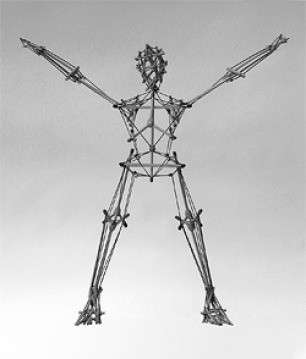What do Buckminster Fuller's geodesic domes and the human body have in common?
In 1932 R. Buckminster Fuller famously philosophized: "Don't fight forces. Use them!" (Fuller, Shelter). A man of many trades — architect, author, designer, futurist, inventor, and the second president of Mensa — he applied this mantra throughout many aspects of his work. In particular, it is more or less the backbone of his studies of and theories on synergetics, an interdisciplinary science that explores the formation and self-organization of patterns in systems. Fuller believed that all experience could be communicated using geometric concepts, and further claimed that the natural analytic geometry of the universe is based on tetrahedra, or triangular pyramids. He explored these ideas through studies of the close-packing of spheres and tensile and compressive stabilization models, noting that tension and compression are not opposites, but rather complements that can be found together; when the two forces are harmonious, continuous pull is balanced by equally discontinuous pushing forces. This synergy between compression and tension is what Fuller calls tensegrity, "a system that stabilizes itself mechanically because of the way in which tensional and compressive forces are distributed and balanced within the structure (Ingber 48-9). It is the underlying principle behind what is perhaps his most well-known invention, the geodesic dome — a nearly spherical shell structure based on a network of triangular elements lying approximately on the surface of a sphere. On a grander scale, it is also a fundamental property of several self-assembled systems within the body, from the anatomical to the cellular to the molecular level.
Fuller originally coined the term tensegrity, a portmanteau of tensional integrity, while studying "energetic-synergetic geometry" during World War II. He provides a comprehensive definition of the term in his book Synergetics:
Tensegrity describes a structural-relationship principle in which structural shape is guaranteed by the finitely closed, comprehensively continuous, tensional behaviors of the system and not by the discontinuous and exclusively local compressional member behaviors. Tensegrity provides the ability to yield increasingly without ultimately breaking or coming asunder (Fuller, Synergetics 372).
Tensegrity structures fall into two main categories — prestressed and geodesic. Both types rely on continuous transmission of tensional forces in order to maintain their shape, and stabilize themselves through decentralized tension and local compression; an increase in tension on one part of the structure causes increased tension on other parts of the structure – even those on the opposite side — which is then balanced out by increased compression within other parts of the structure. The former encompass structural members which are already in tension or compression before they are exposed to any external force, stabilizing themselves through a phenomenon called prestress; within these structures, "the compression-bearing rigid struts stretch, or tense, the flexible, tension-bearing members, while those tension bearing members compress the rigid struts. These counteracting forces, which equilibrate throughout the structure, are what enable it to stabilize itself" (Ingber 49).
Geodesic tensegrity structures are "frameworks made up of rigid struts, each of which can bear tension or compression" (Ingber 49). These struts are positioned to hold the joints that make up the framework into fixed places, so as to stabilize the entire structure. Perhaps the most familiar example of these structures is the geodesic dome, immortalized by Fuller's golf-ball-esque Spaceship Earth building at Disney's Epcot. Influenced by the notion that the strongest possible homogenous truss is cyclically tetrahedral, a conclusion he reached from his studies of synergy, Fuller developed geodesic domes in the late 1940s to demonstrate the ways in which these ideas can be applied to housing and architecture.1 A geodesic dome is a sphere — or ball-shaped structure comprised of a complex network of rigid rods connected into triangles, or tetrahedral, which form a roughly spherical surface. These triangular elements have local rigidity as well as distribute tension across the entire structure; each rod can withstand both tension and compression depending on where and how much pressure is applied, and the omnitriangulated surface provides an inherently stable structure. Moreover, the spherical shape of the structure encloses the maximal volume for the least amount of surface area. The geodesic dome's durability, minimization and efficient use of building materials, and mobile flexibility — its modular structure makes it easy to transport and build — were the source of its appeal to Fuller, who hoped it would provide a solution to the post-war housing crisis (Bowers).
The presence of tensegrity structures is not limited to avant-garde architecture, however. Nor are the principles of tensegrity merely the product of the human mind; rather, they manifest themselves within countless patterns in nature. Both prestressed and geodesic tensegrity structures are found in a variety of natural self-assembled systems, including carbon atoms, water molecules, proteins, viruses, cells, tissues, and animals (Ingber 48). Of particular interest is their prevalence in the human body, on an anatomical, cellular, and molecular level.
On an anatomical level, the human body provides a good example of a prestressed tensegrity structure. Bones act as struts resisting the pull of tensile muscles, tendons and ligaments. Moreover, the stability of the shape of the body, or its stiffness, of the body is a function of the tone, or prestress, of its muscles (Ingber Lab). As Ingber puts it, "We are 206 compression-resistant bones that are pulled up against the force of gravity and stabilized through a connection with a continuous series of tensile tendons, muscles, and ligaments" (Ingber Lab).
The principles of prestressed tensegrity are similarly applicable on the cellular level; although, as we shall see later on, geodesic structures are also found in the cell on a smaller scale. The cell possesses a molecular framework called the cytoskeleton enclosed within the surface membrane that mechanically stabilizes the cell. The cytoskeleton is comprised of three different types of molecular protein polymers, called microfilaments, intermediate filaments and microtubules. The microfilaments, which are the thinnest proteins in the cytoskeleton, comprise a network that extends throughout the cell, exerting tension by pulling the cell's external membrane and everything in between towards the nucleus at its center (Ingber, The Bridge). To counterbalance the tensional forces, the microtubules — the thickest protein chains of the three — act as struts that bear compression. The adhesions of the extracellular matrix, or the "anchoring scaffolding to which cells are naturally secured in the body," create an external interconnected compression force (Ingber 51). The contractile actomyosin apparatus — rigid actin filament bundles which bear compression by pushing the cell membrane and its internal components outwards – generates the tensional prestress that stabilizes the entire cell (Ingber, The Bridge). The intermediate filaments connect the microfilaments, microtubules, the cell membrane, and the cell nucleus to one another and "act as guy wires, stiffening the central nucleus and securing it in place" (Ingber 51). Some individual filaments have dual functions and therefore "bear either tension or compression in different structural contexts or at different size scales (e.g. contractile microfilaments generate tension, whereas actin microfilament bundles that are rigified by cross links bear compression)" (Ingber Lab).
This network of molecular struts and cables allows the cell to alter the balance of tension and compression throughout its structure in order to maintain its shape, even when external forces are imposed upon it. When cells are stretched or face other increases in prestress, they do not lose their original shape but rather stiffen themselves by varying the prestress within the cytoskeleton. Prodding the outside of a cell, for instance, affects the tension felt throughout the interlinked proteins of the cell (Ingber 53). Like Fuller's geodesic domes, the cell's durability is derived from its capacity to distribute tension throughout its structure as well as respond to and neutralize tensional forces with specialized compression. Though the cellular tensegrity model is a prestressed tensegirty configuration, recent work by mathematician Robert Connelly proves that there is a common structural basis for prestressed and geodesic structures; the same fundamental mathematical rules describe the closest packing of cells within the extracellular matrix as they do the different geodesic forms (Ingber, Tensegrity 2).
Several geodesic tensegrity structures naturally occur on the molecular level. Basement membrane proteins, polyhedral enzyme complexes, clatrin-coated transport vehicles, viral capsides, lipid micelles, individual proteins, and RNA and DNA molecules all employ hexagonal arrangements (Vondrejs). The cell's microfilament network itself is a geodesic tensegrity structure. Contractile microfilaments within the cytoskeleton form lattices that naturally assemble themselves locally into different forms, including geodesic networks of triangles (Ingber 53).
Geodesic forms are also found in human red blood cells. A recent study conducted by scientists at the Jacobs School of Engineering determined that the red blood cell's membrane skeleton is comprised of a network of over 30,000 protein hexagons which look similar to a microscopic geodesic dome. At the center of each hexagon, an elongated protein complex, called a proto-filament, acts as a rigid rod that moves and compresses in response to pulling forces. These proto-filaments stabilize red blood cells in the same manner as the rods of a geodesic dome; according to the UCSD researchers, "the more a red blood cell is mechanically deformed, the more likely its individual proto-filaments will rotate left and right" in order to maintain the cell's shape and stability (ScienceDaily).
It is clear that tensegrity structures, both prestressed and geodesic, are prevalent in many natural and man-made systems, from the architecture of Buckminster Fuller to the architecture of the body on an anatomical, cellular, and molecular level. What is particularly fascinating about these congruities is that their discoveries had no direct influence on one another; Buckminster Fuller did not fashion his tensegrity models after cellular structure, nor did Ingber or other scientists set out to hunt for geodesic domes within the cell. However, Fuller's geodesic dome initiated a common language and reference point for scientists to use when navigating their studies of cellular tensegrity; The Ingber Laboratory notes on the Buckminster Fuller Institute's website:
We introduced the concept that living cells stabilize their internal cytoskeleton, and control their shape and mechanics, using an architectural system first described by Buckminster Fuller, known as tensegrity (The Ingber Lab).
Indeed, the convergence of these two tensegrity theories is no coincidence. Just as Buckminster Fuller sought to design a maximally efficient and resilient structure, so too did Ingber seek to understand the efficiency and resilience of various structures and systems of the human body. Both speak to a fundamental understanding of the ingenuity of self-assembling structures and their methods of maintaining stability; when you use forces, you don't need to fight them.
Sources
Bowers. Robert T. "Geodesic Domes," The R. Buckminster Fuller FAQ 26 Nov 2002. 24
Nov 2008 http://www.cjfearnley.com/fuller-faq-4.html
Fuller, Buckminster. Shelter: A correlating medium for the forces of Architecture. 2nd.
1932.
Fuller, Richard Buckminster. Synergetics. 1982. New York, NY: Macmillan Pub Co,
1982.
Ingber , Donald E. . "The Architecture of Life ." Scientific American Jan 1998: 48-57.
Ingber, Donald E.. "Mechanochemical Basis of Cell and Tissue Regulation." The Bridge
Vol 4 No 3Fall 2004 24 Nov 2008
<http://www.nae.edu/NAE/bridgecom.nsf/weblinks/MKEZ-65RHQL>.
Ingber, Donald E.. "Tensegrity I. Cell Structure and Hierarchical Systems Biology."
Journal of Cell Science (2003): 1157-1173.
"Scientists Discover Secret Behind Human Red Blood Cell's Amazing Flexibility,"
ScienceDaily 25 Oct 2005. ScienceDaily LLC. 24 Nov 2008 <http://www.sciencedaily.com/releases/2005/10/051024085853.htm>
"Tensegrity and Complex Systems Biology," Ingber Lab: Children's Hospital
Boston/Harvard Medical School 2004. The Ingber Lab. 24 Nov 2008 <http://www.childrenshospital.org/research/ingber/Tensegrity.html>
Vondrejs. Vladimir. "Tensegrity Structures in Science, Technique, and Art," 24 Nov
2008 <http://64.233.169.132/search?q=cache:ilIiC24Dh_gJ:www.sciart-cz.eu/pdf/Vondrejs.pdf+geodesic+domes+and+cell+structure&hl=en&ct=clnk&cd=8&gl=us&client=firefox-a>
This article originally appeared on Evolver.net.













